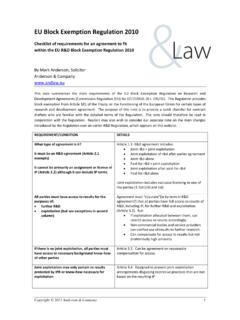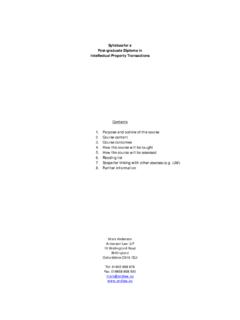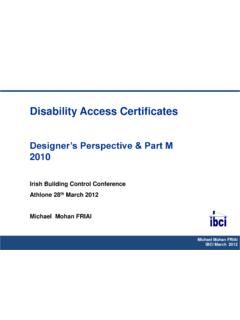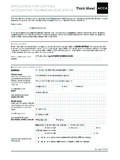Transcription of New EU R&D Agreements Regulation
1 New EU R&D Agreements Regulation Trumpets sound and angels sing in Heaven, there's a new R&D Regulation for 2011! By Mark Anderson, Solicitor Anderson & Company A week before Christmas, the new EU block exemption Regulation for research and development ( R&D ) Agreements (the new Regulation ) was published in the Official Journal. The reference is Commission Regulation (EU) No 1217/2010, OJ L335/36 ( ). The previous Regulation was due to expire; hence the need for a new Regulation . The new Regulation came into force on 1st January 2011 and will expire on 31st December 2022.
2 Agreements that contain anti-competitive terms may be void under Article 101 of the Treaty on the Functioning of the European Union and may cause the parties to be liable for fines. There may also be a risk of legal action by third parties who are adversely affected by the anti-competitive behaviour. Article 101 was previously known as Article 81 of the EC Treaty; older readers will remember that in an even earlier incarnation it was known as Article 85 of the Treaty of Rome. The new Regulation provides automatic clearance or block exemption from Article 101 for R&D-related Agreements that fit within the terms of the Regulation .
3 In US terminology it provides a safe harbor . for such Agreements . The new Regulation has a similar look and feel to the old Regulation that it replaces. The main changes in the new Regulation can be summarised as follows: R&D funding Agreements are covered. The new Regulation specifically includes Agreements to fund R&D within its scope, as well as Agreements for joint R&D. The previous Regulation focused only on joint R&D. Arguably when one party merely pays for R&D to be performed, there is no joint R&D. In our view, this is a welcome change.
4 Market share limits for R&D funding Agreements . As was the case under the old Regulation , block exemption is not available under the new Regulation if the parties are competitors and their combined market share (in either the relevant product market or the relevant technology market) exceeds 25%. The new Regulation goes further and states that, in the case of R&D. funding Agreements , or joint exploitation arrangements arising from R&D funding Agreements , this 25% cap applies to the combined market share of the funding party and all of the parties with which the funding party has entered into R&D Agreements with respect to the same products or technologies.
5 In practice, the funded party may not have sufficient information about the other funded parties to make this calculation. In our view, this change is undesirable. Exclusive licensing to one of the parties is permitted. The previous Regulation permitted certain restrictive terms where there was joint exploitation of the results of joint R&D. However, it was unclear whether an arrangement whereby one party received an exclusive, worldwide Copyright Anderson & Company 2011 1 commercialisation licence from the other party amounted to joint The new Regulation permits such exclusive licensing arrangements, subject to conditions including the right of each party to have access to the results for the purposes of further research.
6 In our view, this is an important and welcome change, which is long overdue. Terms that must be included in the R&D agreement . A surprising change in the new Regulation , which to the author's recollection does not feature in other block exemptions, is that if the agreement is to receive the block exemption, it must stipulate the following matters. The author interprets the word stipulate to mean that the agreement must include a specific clause or clauses stating the following matters: o Access to the results. The R&D agreement must stipulate that all the parties have access to the final results of the R&D, including any resulting IP, for the purposes of further research and development.
7 In the case of contract research organisations, universities and similar bodies, they need only have access for research (ie not development). In principle the parties must also have access for further exploitation, but this is subject to several exceptions. The exceptions include where the parties have agreed that one is exclusively licensed, or where one party is a university or contract research organisation. o Access to pre-existing know-how. Where the R&D agreement provides only for R&D (ie not joint exploitation), it must stipulate that each party must be granted access to pre- existing know-how of the other parties, if this know-how is indispensable for the purpose of its exploitation of the results.
8 This access can be on a fee-paying basis as long as this doesn't impede access. In our view, these changes are undesirable. They indicate a prescriptive approach by the European Commission and leave a number of questions unanswered. For example, research Agreements with universities often state that the university may use the results of the research, but only for academic or non-commercial research. Would such a limitation be permitted? Our best guess is yes , but it would have been better to have made this clear. In relation to access to pre-existing know-how, EU.
9 Framework Agreements anticipate that a party may declare some of its pre-existing know-how to be unavailable to the other members of the research consortium2. This does not seem to be permitted under the new Regulation , unless the consortium agreement also covers joint exploitation (which it will often do). Changes to hardcore restrictions. As with the old Regulation , the new Regulation includes a list of restrictions (known as hardcore restrictions) which, if included in an R&D agreement , 1 rd See the author's detailed comments on this subject in Technology Transfer, 3 edn (editor: Mark Anderson, Bloomsbury, 2010) at page 706, and in previous editions of that work.
10 2. For example, Annex II to the standard European Commission funding contract (Framework 6) includes, at section , the following wording: c) Access rights to pre-existing know-how shall be granted provided that the contractor concerned is free to grant them; d) A contractor may explicitly exclude specific pre-existing know-how from its obligation to grant access rights, by means of a written agreement between the contractors established before the contractor concerned signs the contract or before a new contractor joins the . Similarly Annex II to the standard contract for Framework 7 includes, at Article : Without prejudice to their obligations regarding the granting of access rights, beneficiaries shall inform each other as soon as possible of any limitation to the granting of access rights to background, or of any other restriction which might substantially affect the granting of access rights.








